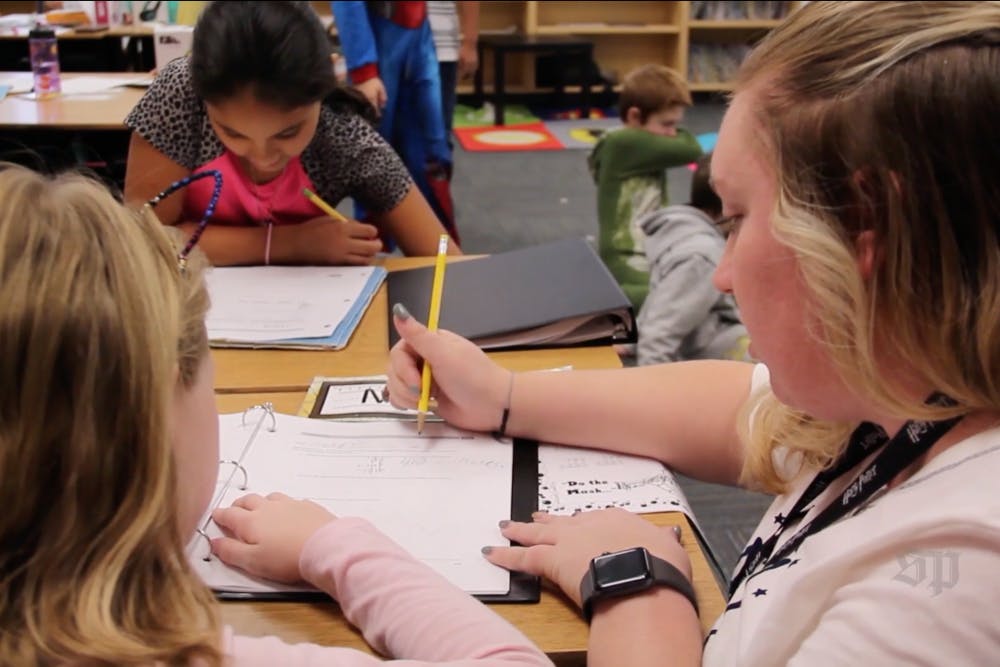ASU researchers are seeking to improve Arizona public schools and combat the state’s teacher shortage with the creation of a graduate residency program preparing students for a career in teaching.
The residency, which researchers say would be the first of its kind in Arizona, would be an intensive program allowing students to gain real-world experience in the classroom while pursuing a master’s degree.
The project is aimed at “bringing more awareness and attention to the profession” while also closing equity gaps in public education, said Victoria Theisen-Homer, lead researcher and postdoctoral research fellow at the School of Social Transformation.
“One of the larger policy issues that we have in Arizona is the teacher shortage,” Theisen-Homer said. “We do not have the teaching candidates right now to fill the positions of the people who are retiring, and we absolutely need more people to come in.”
The project is currently in its early stages, with Theisen-Homer leading a study to determine what conditions are necessary to establish residency in Arizona successfully.
The research, funded by a grant from the Helios Education Foundation and Arizona Community Foundation, is measuring the level of interest in the potential program from public leaders, school administrators and undergraduate students.
Theisen-Homer is joined by research assistants Celesté Zuñiga, a junior studying justice studies and philosophy, and Grace D'Antuono, a master’s student studying social and cultural pedagogy.
After conducting more than 40 interviews with local leaders and recording 1,500 survey responses from undergraduates, Theisen-Homer said the response has been “overwhelmingly positive” so far.
Kathy Wiebke, executive director of the Arizona K12 Center and former elementary school teacher, said teachers face an incredibly stressful and complex working environment that is often overlooked in decision-making.
“We know our classrooms are very crowded, and we are asking our teachers to do so much with so little,” Wiebke said. “I think we have a tendency to take a first-year teacher and put them in a classroom with the same expectation that we have of a 5-, 10- 15-year veteran.”
The residency, she said, provides a solution to this by giving prospective teachers experience in the classroom early on.
What can participants expect?
Students will spend their first year of the two-year residency in the classroom co-teaching with a mentor teacher. Upon completion of the first year, they will be certified to become full-time teachers and will begin teaching at a local Title I school while completing coursework toward their master’s degree.
They will meet regularly with their cohorts and study material focused on inclusive and culturally responsive teaching.
“I think it's that pairing of the scholarship with the actual experience of being in classrooms that makes the residency appealing,” Wiebke said.
Though the program will initially start in the Phoenix metropolitan area, Theisen-Homer hopes to eventually branch out and offer the program in the state’s rural areas and Native American reservations.
Residencies support education by improving faculty retention, eliminating financial barriers and fighting discriminatory hiring practices, D’Antuono said.
The residency program would offer cost-of-living stipends for residents and loan forgiveness for tuition. She said this financial aid will make a career in teaching more accessible to marginalized groups who may not have had access to the schooling prior.
“This could be something that makes it more accessible, and allows for that change to happen,” D’Antuono said.
The program will also be open to applicants of all educational fields and backgrounds.
Zuñiga said they hope to attract people who are not just education majors or fresh out of their undergraduate studies, but also “mid-career switchers” or people who have been in the workforce for years after receiving their bachelor’s degree. Out-of-state students will also be encouraged to apply.
“ASU is good at creating spaces and showing the importance of interdisciplinary interaction,” Zuñiga said. "It's about valuing inclusivity and diversity because it has so much strength in the way that we can respond to social problems."
'We all deserve to be seen'
Theisen-Homer said the classroom should be reflective of the diverse society students are a part of.
“Schools are microcosms of society. What we learn in these classrooms affects our concept of ourselves, our concepts of those around us and concepts of society at large,” she said.
Theisen-Homer saw the importance of inclusion and diversity in her years as a high school English teacher in Los Angeles.
“I, as a white woman, was able to learn how to meaningfully connect with and serve students of color in low-income schools. Without that preparation, I wouldn't have been able to form those kinds of connections and be successful in my practice,” Theisen-Homer said. “We all deserve to be seen for who we are.”
Wiebke said a student's educational experience can be greatly impacted for the better when they have teachers with a variety of lived experiences, adding that representation can have a larger effect on a child’s development.
Lack of representation fuels the systemic inequalities in the workforce, which is why the hiring of more people of color as teachers is at the core of the residency, Zuñiga said.
“There’s just something very special about being able to feel seen by a teacher and to be able to connect with them,” Zuñiga said. “There is a connection of understanding and feeling recognized when you have a teacher that looks like you.”
Theisen-Homer hopes the implementation of this program will help dismantle inequitable hiring practices in schools.
“When you're teaching kids of color to obey their white authority figures, you are reproducing power structures in society,” said Theisen-Homer.
Though students of color make up more than half of the state's student population, three out of every four teachers are white, The Arizona Republic reported.
Prioritizing the employment of people of color as teachers are vital to creating a safe and welcoming environment for students of color at school.
“The best thing that could happen is that people from the communities that we're going to serve in the program will want to be teachers in that community,” Theisen-Homer said. “It's important for white students to also see teachers of color in positions of power and authority to see that the world is multicultural and multiracial. And that you don't just have one person who has the power and authority in these positions.”
As a first-generation student, Zuñiga said this program holds a special meaning for her. Students need to see people in leadership positions that look like them to help them believe they too can hold such roles, she said.
“I went to nine different schools before college. Three different elementary schools; three different middle schools; three different high schools,” Zuñiga said. “I didn't really have a teacher that looked like me until my second semester of my freshman year of college.
“This is a program that I know would have changed my life as a child. If I had a teacher who went through this, I'm sure my life would have been very different, just in the sense of what I believe I can do.”
Celesté Zuñiga was a reporter for The State Press in 2020 but did not contribute to the writing or editing of this article.
Reach the reporter at sreyes23@asu.edu and follow @r_salma_ on Twitter.
Like The State Press on Facebook and follow @statepress on Twitter.
Continue supporting student journalism and donate to The State Press today.





